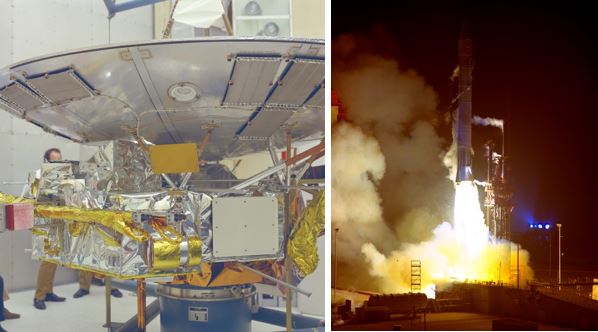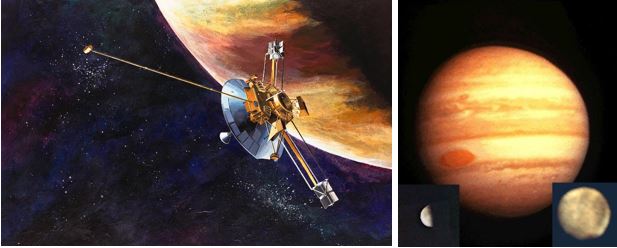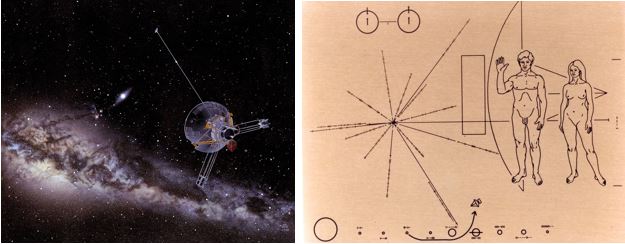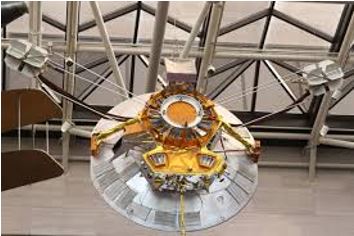By the time it reached its target, the Pioneer 10 spacecraft had been traveling through space for 21 months, traversing regions of the solar system never before explored by human made robots. Built by TRW Systems in Redondo Beach, California, and managed by NASA’s Ames Research Center in Silicon Valley, California, Pioneer 10 was the first spacecraft to explore the solar system’s largest planet Jupiter.
Following its launch from Cape Kennedy on Mar. 2, 1972, Pioneer 10 became the fastest human-made object: traveling at more than 32,000 miles per hour after leaving Earth, it passed the orbit of the Moon in less than 11 hours. Just four months after launch, on Jul. 15, it left the inner solar system and became the first spacecraft to enter the asteroid belt. At the time, it was uncertain whether it would traverse it safely since the density of particles large enough to damage the craft was not yet known. It passed within 5.5 million miles of an unnamed 0.5-mile diameter asteroid on Aug. 2 and the 15-mile wide asteroid 307 Nike on Dec. 2, 1972. After seven months, on Feb. 15, 1973, Pioneer 10 emerged from the asteroid belt unscathed. During its flight from Earth, Pioneer 10 made measurements of the solar wind, and in August 1972, in conjunction with several Pioneer solar orbiting spacecraft, it recorded details of a massive solar storm.
The 571-pound spacecraft carried 11 instruments for its close-up study of Jupiter and interplanetary space during its journey. These instruments were a helium vector magnetometer to measure Jupiter’s magnetic field; a quadrispherical plasma analyzer, a charged particle instrument, a cosmic ray telescope, a Geiger tube telescope, and a trapped radiation detector to measure the solar wind and radiation levels; meteoroid detectors and an asteroid/meteoroid detector to record interplanetary dust particles; an ultraviolet photometer to determine the quantities of hydrogen and helium in space and on Jupiter; an imaging photopolarimeter to return images of the planet; and an infrared radiometer for temperature measurements. Pioneer 10 used plutonium-238 in two radioisotope thermal generators (RTG) to supply power to its systems and instruments, since at the giant planet’s distance from the Sun, capturing enough solar energy would have required solar arrays prohibitively large.
On Nov. 6, 1973, while still 16 million miles from Jupiter, Pioneer 10 began to image the giant planet with the photopolarimeter, and shortly thereafter began to take measurements with its other instruments as well. Twenty days later, the spacecraft passed the front of Jupiter’s bowshock, where the solar wind clashed with the planet’s magnetosphere. By Dec. 1, the spacecraft was returning images of the planet exceeding the best pictures from Earth. Two days later, Pioneer 10 raced by Jupiter at a distance of 82,178 miles traveling at 78,000 miles per hour, with six of its instruments operating continuously during the closest approach. The spacecraft also captured low resolution images of Callisto, Ganymede, and Europa, three of the four large Galilean moons of Jupiter. An image of the fourth Galilean satellite Io was taken but lost to the intense radiation environment around the planet. After its closest approach, Pioneer 10 passed behind Jupiter as seen from Earth. By analyzing the spacecraft’s radio transmissions, scientists could infer information about the planet’s atmosphere. During the encounter, which ended Jan. 2, 1974, Pioneer 10 returned about 500 images of the planet and its satellites.
The scientific and operational return from Pioneer 10 was significant. First, the spacecraft proved that the asteroid belt could be safely traversed to enable future exploration of the outer solar system. Second, it returned new information about the conditions of interplanetary space in the outer solar system, including the solar wind and cosmic radiation. And third, during its encounter with Jupiter, Pioneer 10 either confirmed existing knowledge or made new discoveries. It confirmed the existence of Jupiter’s strong magnetic field and described its interaction with the solar wind. By making the first infrared observations of Jupiter’s night side, it confirmed that due to a source of internal heating, the planet radiates 2 to 2.5 times more heat than it receives from the Sun. These findings provide clues about Jupiter’s interior composition. It found that the densities of the four large Galilean satellites decreases with distance from the planet, a phenomenon reflected in the innermost planets of the solar system. And it confirmed that the satellite Io has an ionosphere. As many questions as it answered, Pioneer 10 raised many more, as is the case with all scientific inquiry. Those questions would be left to its successors to try to answer.
Planned for 21 months of operations, just long enough to reach Jupiter and study the giant planet, Pioneer 10 continued to send back data on interplanetary space in the outer reaches of the solar system. On Jun. 13, 1983, still operating normally and returning valuable information about conditions in interplanetary space in the outer solar system, it passed the orbit of Neptune, then the outermost planet, and became the first human-made object to leave our solar system. NASA maintained regular contact with Pioneer 10 until Mar. 31, 1997, and intermittent contact thereafter. The power generated by its RTG’s had diminished to the point where it could no longer keep Pioneer’s transmitter operating, and the spacecraft sent its last signal to Earth on Jan. 23, 2003, nearly 31 years after its launch, when it was 7.6 billion miles from Earth. That last signal took 11 hours and 20 minutes to reach Earth.
Should an advanced alien civilization find the Pioneer 10 spacecraft, it carries a plaque providing information about its creators and where it originated. Carl Sagan, Frank Drake and Linda Salzman Sagan designed the plaque. The spacecraft is headed generally in the direction of the star Aldebaran, and is expected to reach it in about two million years.
A full-scale mockup of Pioneer 10 is on display at the Smithsonian Institute’s National Air and Space Museum’s Milestones of Flight exhibit in Washington, DC.
To learn more about Pioneer 10, please visit the NASA Ames Research Center History Archives at https://history.arc.nasa.gov/index.htm






























